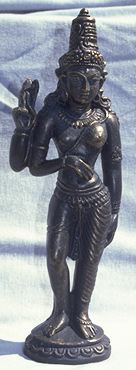"All Gods are one God."
We hear that all the time as Pagans (You'll be hearing it a lot more in this article!), and if we ever do stop to consider what it means, it's only in the most general of terms: Of course they're all one, we know that.
But which one?
It isn't so simple as naming a name, of course. Even the most staunchly culture-devoted Pagan isn't likely to turn "All Gods are one God" into "All Gods are Zeus" (or Dagda, or Odin), but saying it presumes there is a One out there somewhere. But do we mean it? And if we do, why aren't we focusing our faith and worship there?
The fact is that even the most stalwart "All are One" Pagan usually means "All are Two"--Goddess and God, male and female, yin and yang. It's with their supposedly separate, equal and opposite poles that our willingness for reduction abruptly ends. In almost all rituals, spells or rites you can name, All is Two.
But what if we were right to start with, and it really does come down to One? What if the Pagan focus on the uniting of separate and equal opposites has it all backwards...if what we seek to unify, we ourselves put asunder every time we speak of the Divine as separate beings, even if only two?
I don't have answers to these questions, and I may never, but I've been led with a gentle but firm hand to face them nonetheless. If there are final answers to find--a doubtful proposition in itself--I'll almost surely be led toward them in the same way.
I began the same way most Pagans do with the "All are One" idea: hearing it and dismissing it in favor of a more colorful (and less difficult to grasp) array of deities. My teacher told me of the origins of the universe from a single primal energy that spun off from itself all the universe's dualities, beginning with the Goddess and God. What made them divine, she said, was their nearness to that source of all. I absorbed that idea, wondered briefly why we weren't worshipping the source of all that exists, rather than its first children, then shrugged it off and immersed myself in the far more companionable and poetic array of Pagan deities.
Over the 15 or so years that followed, my connections with dozens of deities began to fall away until there were nine. It was then, about 5 years ago, that Gaia (with whom I've had an especially strong relationship) took matters in hand, showing me the interconnections between them all and gradually bringing their numbers down to 3: herself, Kuan Yin and Cernunnos.
And then she cut me loose.
It wasn't really a matter of "OK, you're on your own," even if it felt very like that at the time. There were actually many smaller steps along the way, though I didn't recognize them as parts of a single concept until later. The most powerful clue was the sense that I was reaching out toward something greater still as I walked Gaia's path. She showed me over time that all is one in her...then presented the concept that she is one piece of something greater still.
At about the same time, Shiva touched my life for the first time, and his nature called on me to think further on the idea of the One. He arrived arm-in-arm with a family member who is a student of Tantra, and once the initial rush of purely sexual interest in it settled down a bit, there again was the faceless face of the One.
Tantra is about union, about seeking the One in ourselves, in others and in the universe that is that One. The first few times I explored Tantra as a way to reach out, it was Shiva I touched. Through beginning to know him, I again found a path to what lay beyond him.
I've touched the One, however briefly, and it is still outside my powers to truly describe. Infinity and eternity are hard concepts to grasp, let alone to describe, especially when my meeting with them was an experience of the senses and the spirit, not of the mind. It's a journey of learning and growth, one neither begun at any one point or ending at any other. It is also one I hope will continue to unfold before me in the sharing that is at its core.

The form of Shiva that is most confusing and disturbing to the Western mind (my own included!) is Shiva Ardanariswara, the Lord Whose Half is Woman. Images of him in this form depict him as half male and half female, as if an invisible line runs down the center of his body. What seems to be simply an androgynous figure is actually much more, though it takes something of a feat of mental gymnastics to grasp. What we naturally see as two separate entities, male and female, merged into one, was never separate to begin with. Shiva Ardanariswara is perhaps the best face we can give to the faceless, an image of a whole that we artificially divide in our minds, not of two separate and opposite halves merged.
Armed with that insight, which took me days to even begin to grasp the implications of, my next exploration of Tantric union was very different than before. My lover and I found union not just between man and woman, but between the male and female energies that are embodied in every human being. From that new union, we found Shiva Ardanariswara waiting for us--and what lay within and beyond him. We returned to the One that birthed us for only a moment, but it was long enough for us to understand why it is sought to begin with, and has been for centuries. It was like coming to our true home--and finding out that home lay within us all along.